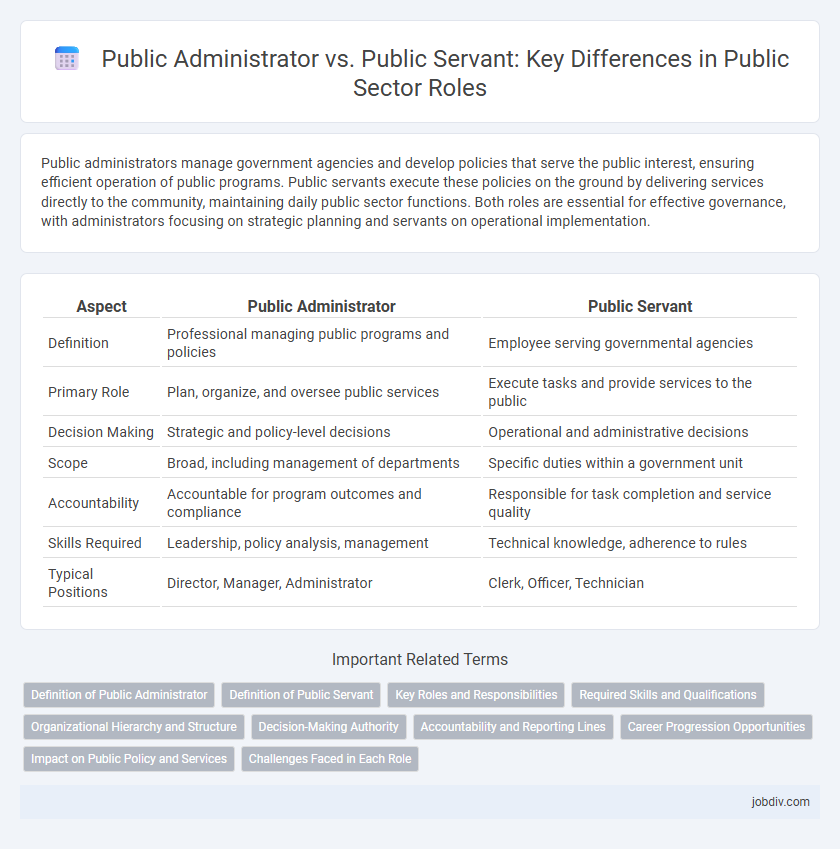Public administrators manage government agencies and develop policies that serve the public interest, ensuring efficient operation of public programs. Public servants execute these policies on the ground by delivering services directly to the community, maintaining daily public sector functions. Both roles are essential for effective governance, with administrators focusing on strategic planning and servants on operational implementation.
Table of Comparison
| Aspect | Public Administrator | Public Servant |
|---|---|---|
| Definition | Professional managing public programs and policies | Employee serving governmental agencies |
| Primary Role | Plan, organize, and oversee public services | Execute tasks and provide services to the public |
| Decision Making | Strategic and policy-level decisions | Operational and administrative decisions |
| Scope | Broad, including management of departments | Specific duties within a government unit |
| Accountability | Accountable for program outcomes and compliance | Responsible for task completion and service quality |
| Skills Required | Leadership, policy analysis, management | Technical knowledge, adherence to rules |
| Typical Positions | Director, Manager, Administrator | Clerk, Officer, Technician |
Definition of Public Administrator
A Public Administrator is a professional responsible for implementing government policies, managing public programs, and overseeing administrative functions within public sector organizations. They ensure effective service delivery, allocate resources efficiently, and uphold public accountability in government operations. This role often requires expertise in public management, policy analysis, and organizational leadership.
Definition of Public Servant
A public servant is an individual employed by government institutions at various levels to implement policies, provide essential services, and uphold public interest. Unlike public administrators who primarily focus on the strategic management and organization of government agencies, public servants carry out day-to-day operational tasks to ensure efficient public service delivery. Their roles encompass a wide range of functions including administrative support, enforcement of regulations, and direct interaction with citizens.
Key Roles and Responsibilities
Public administrators oversee the implementation of government policies, manage public programs, and coordinate resources to achieve community goals, often working in executive or managerial positions. Public servants execute daily operational tasks, provide essential government services, and engage directly with the public to ensure efficient service delivery. Both roles contribute to public sector effectiveness but differ in scope, with administrators focusing on strategic planning and public servants on frontline service execution.
Required Skills and Qualifications
Public administrators require advanced skills in policy analysis, strategic planning, and organizational leadership, often backed by degrees in public administration or related fields. Public servants typically need strong interpersonal skills, customer service expertise, and knowledge of government procedures, with qualifications varying from vocational training to bachelor's degrees. Both roles demand a commitment to ethical standards, public accountability, and effective communication.
Organizational Hierarchy and Structure
Public administrators typically occupy higher-ranking positions within the organizational hierarchy, responsible for policy development, strategic planning, and overall management of public agencies. Public servants generally hold operational or frontline roles, focusing on implementing policies, delivering services, and supporting administrative functions. The distinction emphasizes that public administrators manage and lead within the structure, while public servants execute tasks and maintain daily governmental operations.
Decision-Making Authority
Public administrators possess significant decision-making authority, overseeing policy implementation, managing public resources, and directing government operations with discretion. Public servants execute established policies and procedures, following directives with limited autonomous decision-making power. This distinction underscores the broader managerial role of public administrators compared to the operational focus of public servants.
Accountability and Reporting Lines
Public administrators hold accountability for strategic decision-making and policy implementation within government entities, reporting directly to elected officials or governing boards. Public servants focus on operational tasks and service delivery, adhering to the directives set by public administrators and maintaining clear reporting lines within departmental hierarchies. Both roles are essential for ensuring transparency, compliance, and effective public sector governance through defined accountability mechanisms.
Career Progression Opportunities
Public Administrators often experience broader career progression opportunities due to their strategic roles in policy development and organizational management within government agencies. Public Servants typically have more specialized and operational roles, which can lead to advancement primarily through technical expertise and tenure. Career growth for Public Administrators frequently includes transitioning into senior leadership or executive positions, while Public Servants may progress through hierarchical ranks within specific departments.
Impact on Public Policy and Services
Public administrators design and implement government policies, directly influencing the development and execution of public programs that shape community well-being. Public servants execute these policies and deliver essential services, ensuring operational efficiency and responsiveness to citizen needs. The collaboration between public administrators and public servants enhances policy effectiveness and improves public service outcomes.
Challenges Faced in Each Role
Public administrators often grapple with complex policy implementation challenges, budget constraints, and the need for strategic decision-making to balance diverse stakeholder interests. Public servants face operational hurdles such as adhering to regulatory compliance, managing public expectations, and ensuring efficient service delivery at the grassroots level. Both roles demand navigating bureaucratic structures while fostering transparency and maintaining accountability to the public.
Public Administrator vs Public Servant Infographic

 jobdiv.com
jobdiv.com